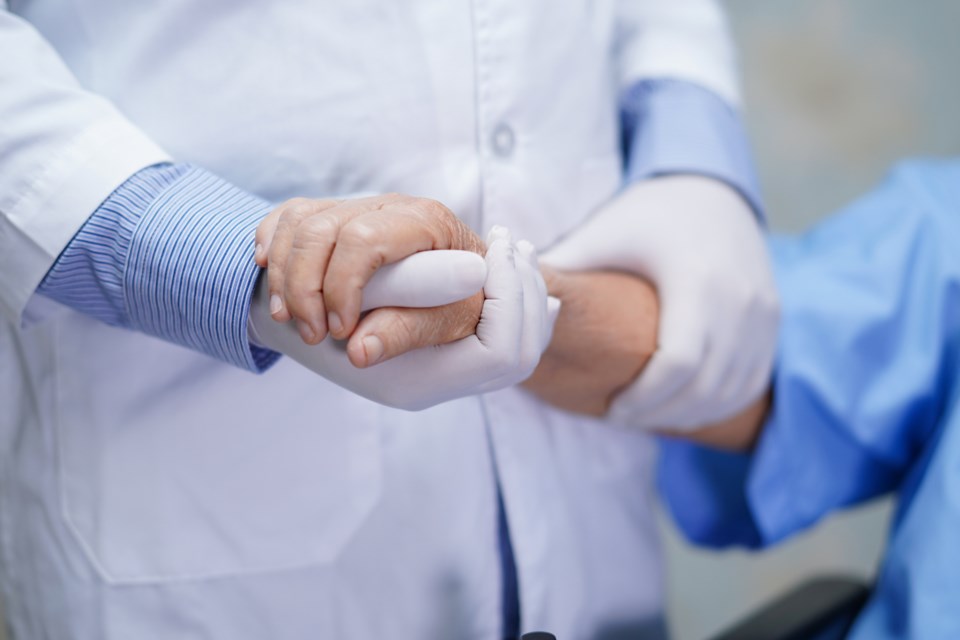As COVID cases spike locally and across the province, Waterloo region's chief medical officer of health Dr. Hsiu Li Wang used Friday’s media briefing to reinforce a message issued earlier this week by “strongly recommending” workplaces cancel or minimize the size of holiday gatherings.
With the local seven-day-average daily case count per 100,000 now at 46, and fear that a rise in cases could significantly strain local healthcare capacity, Wang wants everyone to consider minimizing the size of non-essential holiday gatherings and asks workplaces to begin preparing to work from home in January.
“We need to act now to increase vaccinations and reduce non-essential social contacts,” she said.
On Tuesday, Ontario's COVID-19 Science Advisory Table predicted the province's hospitals could reach capacity by mid-January, with close to 400 COVID-19 patients in intensive care and as many as 3,000 new infections daily, even without accounting for the new omicron variant.
“Slowing the spread will buy us more time to build greater community immunity to get more 5 to 11 year olds vaccinated and to get more third doses in arms,” she said. "The experience in other countries suggests we need to boost immunity with third doses."
Given the likelihood of increased spread from omicron, we all are likely going to come in contact with COVID, Wang said.
The third dose increases immunity and further lessens the chance of severe outcomes.
Third doses will be available to anyone 50 years of age and older starting Monday.
Omicron, which made its first appearance in the neighbouring Guelph Wellington Dufferin Public Health Unit on Friday, is expected to arrive in Waterloo region any day now along with more outbreaks and hospitalizations.
The parents of students in two schools that were closed because of outbreaks, have received rapid antigen screening tests to help track further cases.
And three more schools, including St. Vincent De Paul in Cambridge, will be getting the rapid antigen tests this week.
All schools in the region are in the process of receiving rapid antigen test kits from the province to take home over the holidays.
Wang worries the impact of omicron on local healthcare system could be substantial.
Already facing a surgery backlog, local hospitals could face significant challenges in the coming weeks, she said.
“We have the opportunity to act now to ensure health care system is not overwhelmed.”
Unvaccinated people have a five times higher risk of experiencing symptomatic COVID, a 13 times higher risk of ending up in the hospital, and a 23 times higher risk of ending up in the ICU, Wang said.
Melanie Gillison, intensive care unit pharmacist at St. Mary’s General Hospital and Mary Miller-Lynch, a critical care nurse in the hospital’s ICU, were in on Friday morning’s call to reinforce that message and explain what it’s been like caring for critically-ill COVID patients.
Gillison said treatments for COVID have evolved significantly over the last year as more evidence has come forward on the efficacy of various medications.
But the biggest challenge has been keeping the most effective treatment in supply.
“With so many patients all needing sedation, paralysis and COVID treatment…we’ve experienced shortages like never before,” she said.
The worry now, with increasing rates of infection, is that one of the medications used routinely for critically ill COVID patients is in “very short supply” with only a couple of doses left in the region.
“Another wave of critically ill COVID patients makes me really, really nervous,” Gillison said, urging everyone to get vaccinated.
So far, the fourth wave hasn’t led to the same number of critically-ill patients as the first wave, and for that, Gillison said, they are as a team “extremely thankful.”
“Vaccination keeps people out of the ICUs and the hospital in general,” she said. “This allows us the time and space to take care of all the other non-COVID critically ill patients.”
Miller-Lynch said she worked in the ICU before the pandemic but much has changed over the last 20 months, including the need for critical care staff to develop a new set of skills to manage COVID patients.
One of the common treatments is to have them lay on their stomachs to allow oxygen to get into different parts of their lungs.
The procedure, called “proning,” requires an entire team made up of a minimum of four nurses and a respiratory therapist to turn sedated and paralyzed patients onto their stomachs. It all has to be done while keeping the lines connected, including an intubation tube for breathing, up to a dozen IV lines, a feeding tube, catheter and cecostomy tube to drain stool.
Then 16 hours later, the patients are turned onto their backs.
Early on, ICU staff worried about the possibility the procedure could cause an air leak from the ventilator and expose them to the virus.
“Now it’s a skill we’re all quite comfortable with,” Miller-Lynch said. They’ve developed more efficient and safer ways to intubate patients and the medication they give patients lessens the exposure risk for staff and keeps the patients comfortable.
Still, with all of the personal protective equipment that has to be worn in the ICU and isolation rooms, patient interaction is difficult.
“With the respirator that covers our face, the face shield, the gowns, the gloves, the negative pressure fans and the HEPA filters whirring in the background, communication with a patient can be very hard,” she said. “It’s difficult to speak clearly and it’s difficult for the patients to hear what’s being said.”
The worst part of the job is seeing her patients in isolation “so ill and so afraid” and “not able to have family with them and the only person they see is somebody with their face almost entirely covered,” she said.
“My heart breaks for the patients and families that have had their loved one pass away with nobody but a stranger to hold their hands.”
Combined with long hours and staffing issues, it leaves everyone working in the ICU emotionally and physically exhausted, she said.



